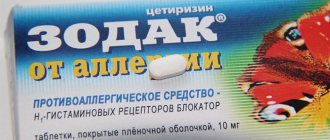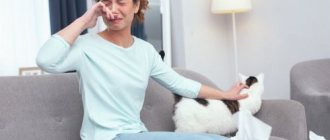Fenistil
The original drug fenistil (INN - dimethindene) from a Swiss pharmaceutical company represents a group of first-generation H1-antihistamines. By blocking H1-histamine receptors, it prevents the development of allergic reactions, thereby providing a pronounced antiallergic effect. Fenistil’s “hit list” includes not only the above receptors: it is capable of removing the body from the influence of other mediators involved in allergic processes, for example, serotonin and bradykinin. The drug significantly reduces the increased permeability of capillary walls caused by an allergic reaction and prevents the strengthening of immediate allergic reactions associated with the secretion of additional amounts of histamine. Fenistil does not have a toxic effect on the heart, and is generally considered a safe drug, which makes it possible to use it in children. Among the main advantages of the drug, its manufacturer (and this is a company quite respected in the global pharmaceutical community) declares the breadth of the spectrum of action (including antiallergic, antipruritic and antiexudative effects) and the rapid onset of development of the pharmacological effect, the peak of activity of which is measured in 15-45 minutes from moment of reception. Another advantage stands out: fenistil is adapted for use in pediatric practice. So, this is, in fact, the only antihistamine produced in drops for oral administration: this “children’s” form of release allows you to accurately measure the required amount of the drug, fortunately, the bottle is equipped with a special dropper dispenser for selecting an individual dose.
To this should be added a pleasant taste, even in the absence of sugar and flavorings. It is recommended to dissolve the drops in a warmed nutritional mixture or give directly from a spoon before feeding. Fenistil has pronounced antipruritic properties, which makes it an effective remedy for insect bites and infectious rashes: with its active participation, swelling, hyperemia and pain characteristic of the above conditions will recede into the background.
As for side effects, fenistil is not a leader here in the bad sense of the word. The sedative effect, which is often reproached by first-generation antihistamines, is rather weakly expressed and is quite comparable to more modern drugs. In addition to drops, fenistil is available in two more dosage forms, but for topical use: gel and emulsion. The gel is convenient in the sense that it has an additional cooling effect. In case of extensive lesions of the skin, allergists recommend combining the use of drops with the use of one of the external forms of the drug, while in pediatric practice they strive to minimize the area of skin exposed to gel treatment. After applying the latter, the treated areas of the skin should not be exposed to sunlight. The oral form of the drug does not combine well with taking tranquilizers, sleeping pills and alcohol, because potentiates their action.
fenistil for allergies reviews
I read a lot of stories about children at BB and now I decided to share our story with AD too. It all started almost a month ago, when my daughter’s cheeks began to slowly and surely turn red. Then the rash spread across the body slowly. Having passed tests for dysbacteriosis, they found Staphylococcus aureus. Of course, they prescribed staphylococcal bacteriophage, then Acipol. Having previously read about the bacteriophage, I realized that this bitterness may not help the baby, because no one prescribed an antibiotic sensitivity test. It was a shame to feed my daughter bacteriophage (and one of the pediatricians recommended giving one dose of bacteriophage as an enema), since she was only a couple of months old. Therefore, my husband and I decided to visit a dermatologist first. As a result of the visit, we were given a prescription to order the ointment from a compounding pharmacy. All the components were decent: distilled water, lanolin, papaverine, etc., only one component was hidden behind the doctor’s seal. We ordered, received, applied... In the morning I looked - my daughter was white, there was no limit to her joy! They finally found a decent treatment without a bacteriophage... They found it, for a couple of days, and then everything started to come out again. So we lived with this ointment for up to 4 months, constantly thinking that it might still cure her of staphylococcus and not torment her. But they kept putting off taking the bacteriophage. Having ordered this ointment again, the pharmacy gave us unused Akriderm ointment, and that’s when I realized how miraculous this ointment is. Imagine my disappointment that I smeared it for so long. Of course, they immediately stopped using it. Then the question arose: how to relieve the itching and fight the rash.
Then we visited an allergist who prescribed treatment: Locoid, Zyrtec, Locobase Ripea or La Rosche Posay Baume B6. I immediately dismissed Locoid for myself, we’ve had enough of hormones. We bought La Rosche Posay Baume B6, the reviews were amazing, I bought it without hesitation. Our effect was the opposite: instead of maximum skin hydration, there was, on the contrary, flaky, dry skin. The cream was left until better times.
We started experimenting with baby creams: various Johnsons, Bübchen, and Russian ones. As a result, we chose Johnson's Baby Care. Now he has become our companion.
All this time my daughter was on breastfeeding. I won’t say that I followed a strict diet; I couldn’t believe that my mother should only eat buckwheat. In fact, even when I was dieting, the rash continued to appear. Therefore, I myself tried to eat more or less hypoallergenic, but also so that the milk was not water.
From 4 months I started introducing her to complementary foods in the form of vegetables (zucchini), hoping that maybe the rash would go away. But it didn't help either.
At 10 months, we went to a homeopath, because I successfully cured my allergies with just such a doctor. Prescribed Bactisubtil and Hepel. We drank it, there was good relief, but again for 1-1.5 weeks.
A year later we went to another dermatologist. The recommendations were as follows: Creon, liquid bifidumbacterin and hygiene (constant moisturizing with cream, washing with soap once a week). We drank everything, but I didn’t notice any special effect.
As a result, we are now 1 year and 4 months old, and still continue to break out if the child eats something new. We finished the GW within a year. Now the rash is not so extensive, more pinpointed. I relieve the itching with suprastin (I give 1/4 tablet at night), fenistil does not help us.
From about 6 months to this day, I smear her exclusively with baby cream, we tried Fenistil gel - there was no effect. The mixture was chosen successfully, Nutrilak Lactose-Free, and we are still using it to this day.
Recently, here on BB I found an article that a decoction of bay leaves soothes itching, now we bathe our daughter in it. I have never tried other herbs, because I myself am allergic to field herbs. There is an effect, but if you ate something thermonuclear, but the bay leaf does not work, but the rash goes away faster.
Our weakest points are the elbow and popliteal folds, and the wrists. Sometimes he scratches until it bleeds, although the skin there is almost clean. The rash usually itches towards night and at night.
Throughout this time, I read one article by Komarovsky about atopic dermatitis. We bought a humidifier, maintained the optimal temperature, and didn’t wrap the child up like cabbage. But! When the temperature in the apartment was really cool (19-20 degrees), the daughter was almost white, as soon as she woke up and began active activity, everything turned red again.
Somehow, the struggle continues, and, of course, it’s very disappointing that my daughter cannot enjoy the garden’s berries, all the fruits and vegetables (there’s no talk of candy at all!), because it’s summer. Sometimes I give her a little banana, or a honeysuckle or Victoria berry, but then the rash comes again. But somehow you need to give the body new products. In the meantime, I will continue to look for new adequate ways to deal with the rash: maybe we will outgrow it, or maybe we will eat something magical and the skin will become clear and white.
Fenistil drops for oral administration 1 mg/ml fl 20 ml
Registration Certificate Holder
GlaxoSmithKline Healthcare (Russia)
Dosage form
Medicine - Fenistil® (Fenistil®)
Description
Drops for oral administration
in the form of a clear, colorless liquid with virtually no odor.
1 ml (20 drops)
dimethindene maleate 1 mg
Excipients
: sodium hydrogen phosphate dodecahydrate - 16 mg, citric acid monohydrate - 5 mg, benzoic acid - 1 mg, disodium edetate - 1 mg, sodium saccharinate - 0.5 mg, propylene glycol - 100 mg, purified water - 888.5 mg.
20 ml - dark glass bottles (1) with a dropper dispenser - cardboard packs.
Indications
- allergic diseases (urticaria, hay fever, year-round allergic rhinitis, food and drug allergies, angioedema);
- skin itching of various origins (eczema, other itchy dermatoses /including atopic dermatitis/, itching due to measles, rubella, chicken pox, insect bites);
- prevention of allergic reactions during hyposensitizing therapy.
Contraindications for use
- hypersensitivity to the components of the drug;
- angle-closure glaucoma;
- bronchial asthma;
- prostatic hyperplasia;
- children up to 1 month;
- I trimester of pregnancy;
- lactation period (breastfeeding).
Carefully
Fenistil® should be prescribed to patients with chronic obstructive pulmonary diseases, epilepsy, and children aged 1 month to 1 year (since their sedative effect may be accompanied by episodes of sleep apnea).
pharmachologic effect
Histamine H1 receptor blocker is a competitive histamine antagonist. Has antiallergic and antipruritic effects. Reduces increased capillary permeability associated with allergic reactions.
It also has an antibradykinin and weak m-anticholinergic effect. When taking the drug during the day, a slight sedative effect may be observed.
The antihistamine effect begins to appear 30 minutes after oral administration, reaching its maximum severity within 5 hours.
Drug interactions
Fenistil® enhances the effect of anxiolytics, hypnotics and other drugs that have a depressant effect on the central nervous system (opioid analgesics, anticonvulsants, tricyclic antidepressants, MAO inhibitors, antihistamines, antiemetics, antipsychotics, scopolamine, ethanol).
Tricyclic antidepressants and anticholinergic drugs (including bronchodilators, antispasmodics) increase the risk of increased intraocular pressure or urinary retention.
The combined use of antihistamines and procarbazine should be avoided.
Dosage regimen
The drug is taken orally.
Children aged 1 month to 12 years
The recommended daily dose is 100 mcg/kg body weight, which is equivalent to 2 drops per kg body weight. The daily dose must be divided into 3 doses.
In children aged 1 month to 1 year
the drug should be used only as prescribed by a doctor and if there are indications for the use of histamine H1 receptor blockers.
For children
over 12 years of age and adults,
the recommended daily dose is 3-6 mg (60-120 drops), divided into 3 doses, i.e. 20-40 drops 3 times/day.
For patients prone to drowsiness, it is recommended to prescribe 40 drops before bedtime and 20 drops in the morning.
20 drops = 1 ml = 1 mg of dimethindene.
For elderly patients (over 65 years old)
no dose adjustment is required.
Overdose
Symptoms:
depression of the central nervous system and drowsiness (mainly in adults), stimulation of the central nervous system and m-anticholinergic effects (especially in children), incl. agitation, ataxia, tachycardia, hallucinations, tonic or clonic convulsions, mydriasis, dry mouth, flushing, urinary retention, fever, decreased blood pressure, collapse.
Treatment:
activated charcoal and a saline laxative should be prescribed; take measures to maintain the function of the cardiovascular and respiratory systems (do not use analeptics).
Side effect
Determination of the frequency of side effects: very often (≥1/10), often (≥1/100 and <1/10), infrequently (≥1/1000 and <1/100), rarely (≥1/10,000 and <1 /1000), very rare (<1/10,000), including isolated reports and reactions with unknown frequency.
From the immune system:
very rarely - anaphylactoid reactions, including swelling of the face, swelling of the throat, rash, muscle spasms and shortness of breath.
Mental disorders:
rarely - anxiety.
From the nervous system:
very often - fatigue;
often - drowsiness, nervousness; rarely - headache, dizziness. From the digestive system:
rarely - gastrointestinal disorders, nausea, dry mouth, dry larynx.
If any of the above side effects worsen, or any other side effects occur, the patient should inform the doctor.
special instructions
In children under 6 years of age, antihistamines may cause increased excitability.
Fenistil® drops should not be exposed to high temperatures.
When administered to infants, they should be added to a bottle of warm baby food immediately before feeding. If the child is already being spoon-fed, the drops can be given undiluted. The drops have a pleasant taste.
Do not exceed the recommended dose.
The drug is not effective for itching associated with cholestasis.
Effect on the ability to drive vehicles and machines
Fenistil® may impair attention, so it should be taken with caution when driving a car, working with machinery, or performing other types of work that require increased attention.
Storage conditions
The drug should be stored out of the reach of children, in its original packaging, at a temperature not exceeding 25°C.
Best before date
Shelf life: 2 years.
Use during pregnancy and breastfeeding
Restrictions during pregnancy - With caution. Restrictions when breastfeeding - Contraindicated.
Fenistil® is contraindicated in the first trimester of pregnancy and during lactation (breastfeeding).
The use of Fenistil® in the second and third trimesters of pregnancy is possible under medical supervision only if the expected benefit to the mother outweighs the potential risk to the fetus.
Use in elderly patients
Restrictions for elderly patients - No restrictions.
For elderly patients (over 65 years old)
no dose adjustment is required.
Use in children
Restrictions for children - With caution.
Contraindicated: children under 1 month of age (especially premature infants).
with caution
to children under 1 year of age, because in them, sedation may be accompanied by episodes of sleep apnea.
Terms of sale
The drug is available without a prescription.
Contacts for inquiries
GlaxoSmithKline Healthcare JSC (Russia)
GlaxoSmithKline Healthcare AO
123112 Moscow, Presnenskaya embankment, 10, fl. 6, room III, room. 9 Tel.




